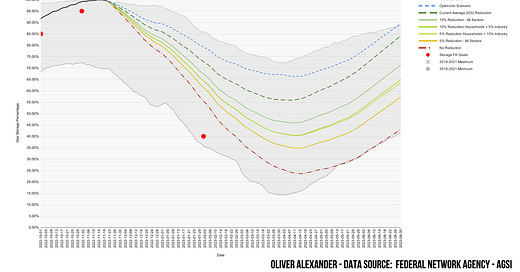Net Withdrawals Beginning: Gas Storage Scenario Update 21.11.22
Nearing the end of November we have begun to see net withdrawals from German gas storage as a result of a week of cold weather.
If you enjoy my content, please consider supporting my work here and on Twitter with a premium Substack subscription.
With just one and a half weeks of November left, German gas storage levels have started to decrease as withdrawals are increasing. On Sunday 20th November the gas storage levels were at 99.55% of the working gas volume. This is down from the maximum reached on the Sunday 13th where German gas storage managed to reach an incredible 100.2% of the working gas volume. A percentage over 100 can be achieved as the stores are measured in TWh and not volume. As such there are several factors including gas pressure and the caloric density of the stored gas that can push the fill level above 100%. Total working gas volume should be thought of as “we have capacity to store at least this much”, rather than the absolute maximum capacity.
The first half of November has had above average temperatures across Germany, though they have dropped closer to the average than they were during October. The temperature differential from the average dropped from around 3°C to 1.7°C above norm.
Gas usage data for week 45 indicates that while temperature is a factor, a sizable chunk of the current savings are not the result of the warmer than average autumn, but a conscious decision by Germans. Total gas usage for week 45 was down -33.38% from the 4 year average, with Household & SLP use being down -35.76% and industry use being down -31.56%. The colder temperature of week 45 brought down the percentage savings by a margin, but based on this data I continue to stand by my earlier estimate of a drop of approx. 22-24% in gas usage for household and SLP customers being non-temperature related. For Industry customers, I estimate this at around 18-20%. The question here is how much is done in the interest of saving gas and how much is done due to high gas prices. This hypothesis will be tested in Week 46.
The past few days have been cold though and have undoubtedly caused increased gas usage in Germany, which has resulted in steady drop of around 0.1-0.12% in total gas stored everyday. I therefore expect that the Week 46 gas usage data that releases on Thursday will show household gas usage much close to the average than we have seen up until now. This should not be taken as an indication that Germans have stopped saving gas though. Weather forecasts for the next week indicate that temperatures should increase over the next week, close to the average temperature for this time of year. The week 46 data should give us a much more accurate indication of how much of the current gas savings are temperature related and how much is a conscious energy saving decision.
Historically the daily net withdrawal of gas from storage has begun during the first or early second week of November. This year Germany managed to make it halfway through the third week before a net withdrawal happened and this seems to have been caused by a period of colder than average weather. It is still possible that storage starts filling again over the coming days as the temperature approaches the norm again.
This brings me to my updated model below:
The storage fill turnaround began this week, though gas fill levels have never been this high so far into November. Currently if Germany continued to use its normal average gas consumption over the winter without any reductions, gas stores will deplete to around 23.5% in mid April. While this puts Germany into a more precarious position in regards to winter 2023 due to a lack of Russian gas imports, it remains at a higher level than April 2018, where levels dipped to 14.25%. Even this highly unlikely pessimistic scenario keeps gas stores on the right side of the 40% fill on the 1st February target. The continued filling of stores passed the middle of November have allowed for this scenario to almost remain within the 2018-2021 minimum. As with earlier scenario updates, we continue to see a situation where it is hard to imagine a scenario where Germany runs out of gas this winter without a serious reduction in imports, presumably through the sabotage of gas infrastructure. The chance of Germany running out of gas is currently close to 0%.
All other scenarios with some gas usage reductions mange to keep Germany at a satisfactory level throughout the winter.
The “Optimistic scenario” has attempted adjust for the temperature related gas savings. With this adjustment, German households and businesses have saved around 22% gas compared to the 4 year average. At the same time German industry, which is less affected by weather and has a more stable gas consumption, has saved around 18%. For the optimistic scenario I have accounted for this, with a decrease in savings to 10% for households and 5% for industry from the beginning of April as the winter and immediate danger passes.
Barring any major crisis (import issues, sabotage, unusually cold weather) I continue to estimate that we will see a scenario between the blue and green dashed lines on the scenario graph. This puts Germany in a good situation for the 2023 winter as well, relieving additional pressure.
As the Wilhelmshaven LNG terminal comes online at the end of December, German gas supplies will be further strengthened, reducing the risk of a drop in supply that can lead to suboptimal scenarios. I will attempt to factor this in properly once we have a solid timeline on when the facility becomes operational.
Additional information on my scenarios can be read here




